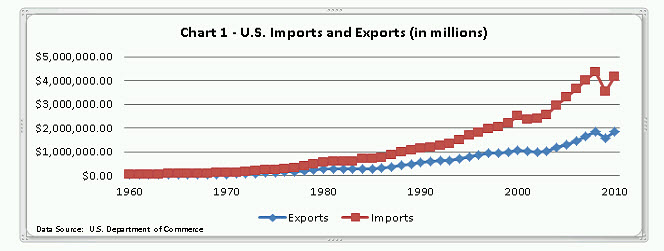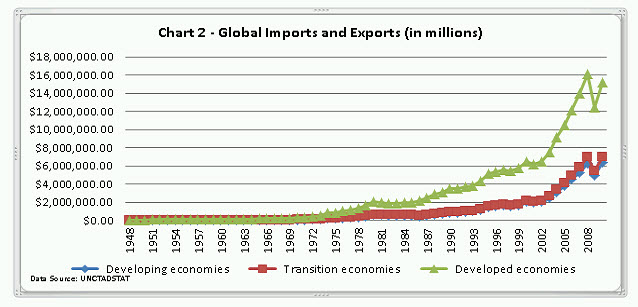Since the earliest days of European immigration to North America, international trade has played an important part of the North American economy. Colonists and other émigrés were highly dependent on international trade companies such as the Hudson Bay Company, Boston Tea Company and the Dutch West Indian Company to provide goods that were available on the continent and to provide access to wealthy European markets for excess goods such as furs, tobacco, and raw materials.
As a nation, the U.S. economy has long maintained trade relationships with a wide range of countries throughout the world as both a means to support U.S. based companies, leverage U.S. financial resources and provide a higher quality of life to residents who benefit from increased choice and potentially lower cost products.
Importance of Trade within the Global Economy
California is one of the largest and most diversified economies in the world with a gross domestic product (GDP) of over $3.1 trillion in 2019. If California were a country, its 2019 GDP would place it 5th among worldwide GDP rankings.
A significant driver of GDP is international trade and foreign investment. As the world's largest economies, it is not surprising that the U.S., Germany, China and Japan are also world's largest importers. As illustrated by the Chart 1 – U.S. Imports and Exports (1960 – 2010), international trade has played an increasingly valuable role within the U.S. economy. Innovations in technology during the 1990s rapidly increased global market integration, and "suddenly" foreign markets that had been previously considered too remote were accessible to trade. These new markets brought access to natural resources for international corporations, as well as created opportunities for a rising middle class who wanted products and services from developed economies.

In the 21st century, trade in the U.S. has dipped due to the dot.com crisis in 2001, the financial crisis, which began in 2007 and later the recession in 2008. Even in the recession, however, global supply chains of goods and services continued to play a dominant role in the nation's economic position.
While not every economic activity is part of a global supply chain, many products and services are. This issue has recently come to the forefronts as Toyota Assembly lines in the U.S. have had to shut down because key parts that are manufactured in Thailand have been unable to be shipped due to flooding. This growing market integration and the significant role of the U.S. within the global markets can be seen by the almost mirror imagine of the global trade patterns in Chart 2 – Global Imports and Exports.

Another indicator of world interconnectedness can be seen in changes in the amount of foreign direct investment (FDI). FDI is when a company from another country invests, either by purchasing an existing company in another country or building a new site of operations in the foreign country in what is called "green field investment." Chart 3 – Global Inward FDI shows foreign investment, over the same time period as the previous two charts. Overall the chart displays a similar pattern to international trade, except that the dot.com crisis had a greater impact on investment capital.

The U.S. is the largest receiver of FDI in the world and California businesses receive the largest percentage of FDI in the U.S. As globalization and market integration continue to evolve, it is expected that FDI, as we have already seen in venture capital, will be more dispersed across the world.
Importance of Trade within the California Economy
Historically, the state's significance in the global marketplace resulted from a variety of factors, including: its strategic west coast location that provides direct access to the growing markets in Asia; its economically diverse regional economies; its large, ethnically diverse population, representing both a ready workforce and significant consumer base; its access to a wide variety of venture and other private capital; its broad base of small- and medium-sized businesses; and its culture of innovation and entrepreneurship, particularly in the area of high technology.
A key driver of the state's $3.1 trillion economy is international trade and its related goods movement activities. The Trade, Transportation and Utilities Sector (20% of all California workers) is the most closely dependent on goods movement. In the Manufacturing Sector more than one-fifth (21.9%) of the workers directly depend on exports for their jobs. Overall, manufacturing contributed over 10% of the state's GDP and provided 8.1% of all jobs in the state in 2015.
Manufacturing employment is sometimes referred to as the gold standard because it pays high wages (usually with benefits), supports the state's access to the broader global market and provides a key link in the extended network of small and medium sized businesses that participate in the production, distribution and retail supply chain.
Due to their ability to provide specialized goods and services, small- and medium-sized businesses are crucial to the state's international competitiveness and are an important means for dispersing the positive economic impacts of trade within the California economy. Of those companies a total of 75,175 (8.4%) exported goods from California, 72,032 (95.8%) were small and medium-sized companies with fewer than 500 employees.
Manufacturing in California, however, even prior to the current economic recession, faced many challenges maintaining global and domestic competitiveness, including providing a skilled workforce to support the changing needs of manufacturing and goods movement, and maintaining cost-effective productivity in the face of lower safety and wage standards in emerging foreign markets.
The California Manufacturers and Technology Association (CMTA) estimates that California lost 633,000 manufacturing jobs from its peak in January 2001 to November 2010. While part of this reduction reflects the loss of high-tech jobs in 2001 and 2002 and the current recession, the industry, as a whole, is suffering. Compared to other states, however, California's loss of manufacturing jobs more severe, as shown in Chart 4 – Loss of Manufacturing Jobs – Comparison of Western States.
Chart 4 – Loss of Manufacturing Jobs – Comparison of Western States(2001-2010 seasonally adjusted) | ||||
Arizona | California | Nevada | Oregon | Texas |
-30% | -34% | -12% | -29% | -21% |
Source: CMTA, based on data from US Bureau of Labor Statistics and California Employment Development Department |
Manufacturing costs in California are estimated by the CMTA, based on data from the US Bureau of Labor Statistics, to be 24% higher than the national average. The quality and development process related to building and maintaining infrastructure is one component of those costs. In the subsections that follow, there is a more expanded discussion on the role of infrastructure in remaining globally competitive.
Fact Sheet California's Trade Economy
Fact Sheet on California's trade relationship with Mexico
Fact Sheet on California's trade relationship with Canada
Fact Sheet on California's trade relationship with China
Fact Sheet on California's trade relationship with South Korea
Fact Sheet on California's trade relationship with India
Fact Sheet on California's trade relationship with Argentina
